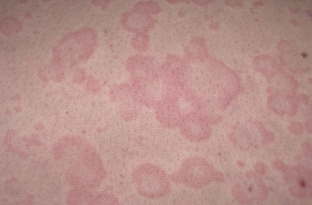In previous articles, we discussed the causes of toxicoderma, the features of drug toxicoderma, as well as the main symptoms of toxicoderma. In the diagnosis and treatment of toxicoderma, there are also many important points and approaches that the doctor should be aware of.
The diagnosis of toxicoderma should be differentiated from exudative erythema multiforme, plaque parapsoriasis, lichen rosea, roseolous syphilis, pseudolymphoma syndrome, Ritter's exfoliative dermatitis, premycotic stage of mycosis fungoides. Read more about diagnostics on estet-portal.com.
What diseases is it important to differentiate the diagnosis of toxicoderma with?
From multiform exudative erythema of infectious-allergic genesis, drug-induced erythema differs in the absence of typical ring-shaped elements with depression in the center, which form with the rapid centrifugal growth of an inflammatory spot or papule in erythema multiforme and are localized mainly on the extremities, as well as the occurrence relapses in the autumn-winter period.
Toxic-allergic form of exudative erythema multiforme is a type of toxicoderma. Plaque parapsoriasis differs from manifestations of toxicoderma by the presence of mild infiltration at the base of erythematous elements, which are not spots, but plaques. Parapsoriasis is characterized by latent peeling, as well as an exclusively torpid course (sometimes for many years), while exacerbations of the disease do not depend on medication.
Pink lichen, in contrast to the typical manifestations of toxicoderma, is characterized by erythematous-squamous maculopapular elements of a somewhat elongated shape, located on the skin of the body along the Langer lines, with peeling in the form of crumpled tissue paper. Rashes with pink lichen persist for 6-8 weeks, after which they disappear without a trace, according to estet-portal.com .. Their appearance is not associated with taking medications. The roseolous rash in syphilis usually does not flake, does not tend to merge, and is not accompanied by itching.

Difficulties in diagnosing toxicoderma
It is not easy to establish the cause of the diagnosis of toxicoderma, and often – impossible. Differential diagnostic value is the presence of symptoms of damage to internal organs, the nervous system, blood vessels in drug toxicoderma. Differentiate bullous toxicoderma on the genitals (in the erosive stage) should be from hard chancre, genital herpes, erosive balanoposthitis; roseolous, papular, pustular toxicoderma – must be distinguished from the corresponding syphilides of the secondary period of syphilis.
Roseolous manifestations must also be differentiated from rashes with rubella, measles, scarlet fever; bullous form – from chickenpox, pustular – from pyoderma.
When making a diagnosis of toxicoderma, all other causes of rashes, in particular infectious ones, are excluded. This is not always easy to do: rashes with a viral infection are indistinguishable from those caused by any drug prescribed before the treatment of this infection. Evaluate the time from the start of drug treatment to the onset of symptoms and the effect of discontinuation of the drug (whether there is an improvement). Find out if there have been similar reactions to this drug in the past.
Various diagnostic tests, including skin tests, are used to confirm the causal role of the suspected factor.
More convincing results are given by provocative tests, in which the etiological factor is administered in the same way as the drug that caused toxicoderma is used. So, if toxicoderma occurred when the drug was taken orally, then the test should be taken orally, prescribing its minimum therapeutic dose. The test is considered positive in the development of recurrence of toxicoderma.
Provocation tests require special care and should not be performed on patients who have had a severe form of toxicoderma. Only after differential diagnosis and laboratory tests, the diagnosis of toxicoderma is appropriate and justified.
There are laboratory diagnostic tests that can also confirm the diagnosis of toxicoderma:
- leukocyte agglomeration test according to Fleck;
- Basophil degranulation test according to Shelley;
- lymphocyte blast transformation reaction;
- platelet reactions;
- hemolytic tests.
Basic principles of treatment after diagnosis of toxicoderma
The most important condition for the treatment of toxicoderma – interruption of the impact of the etiological factor (cancel prescribed drugs, release from work associated with exposure to occupational hazards, exclude contact with household chemicals, prescribe a hypoallergenic diet).
For accelerated removal of toxic substances from the body, diuretics and laxatives are prescribed; restore the function of the digestive tract, liver, kidneys with toxicoderma of endogenous origin.
Enterosorption is required. The appointment of antihistamines is mandatory. In severe toxicoderma, corticosteroid preparations are used orally and intravenously (prednisolone, dexamethasone, hydrocortisone). To improve the functioning of the digestive tract, enzymes and eubiotics are prescribed. Perhaps intravenous administration of polyvidone, as well as plasmapheresis, hemosorption. External treatment after the diagnosis of toxicoderma is usually carried out with antipruritic talkers, corticosteroid ointments, creams and aerosols.







Add a comment